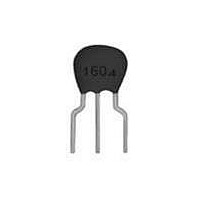CSTLS16M0X55-B0 Murata, CSTLS16M0X55-B0 Datasheet - Page 17

CSTLS16M0X55-B0
Manufacturer Part Number
CSTLS16M0X55-B0
Description
Resonators 16.00MHZ .5% LEADED
Manufacturer
Murata
Specifications of CSTLS16M0X55-B0
Tolerance
0.5 %
Termination Style
Through Hole
Operating Temperature Range
- 20 C to + 85 C
Dimensions
6.5 mm W x 5.5 mm L x 3.5 mm H
Load Capacitance
30 pF
Frequency
16 MHz
Lead Free Status / RoHS Status
Lead free / RoHS Compliant
Available stocks
Company
Part Number
Manufacturer
Quantity
Price
Company:
Part Number:
CSTLS16M0X55-B0
Manufacturer:
MURATA
Quantity:
240 000
!Note
becomes like Fig. 4. Z
(Note 3)
Fig. 3 shows the equivalent circuit of an emitter
grounding type transistor circuit. In the figure, Ri
stands for input impedance, R
impedance and
rate.
When the oscillation circuit in Fig. 2-6 is expressed
by using the equivalent circuit in Fig. 3, it
the table for each Hartley type and Colpitts type
circuit.
The following 3 formulas are obtained based on
Fig. 4.
Please read rating and !CAUTION (for storage, operating, rating, soldering, mounting and handling) in this PDF catalog to prevent smoking and/or burning, etc.
This catalog has only typical specifications. Therefore, you are requested to approve our product specifications or to transact the approval sheet for product specificaions before ordering.
Fig. 4 4 Hartley/Colpitts Type LC Oscillation Circuits
Notes
Z
Z
Z
Z
(Z
1
2
1
1
R
1
i
1
+Ri) i
0
+Z
i
1
+(R
2
i
2
1
–(Z
R
0
–Z
+Z
Hartley Type
1
2
1
i
2
+Z+Z
stands for current amplification
1 / j C
3
) i
j L
j L
=0
-
+
2
1
2
–Z
R
R
0 1
R
1
1
0
Fig. 3 3
) i
, Z
2
i
3
3
=0
2
=0
and Z are as shown in
-
+
2
0
R
0 1
stands for output
R
0
Z
2
Z
Colpitts Type
3
···················(1)
···················(2)
···················(3)
1 / j C
1 / j C
j L
Z
1
L1
L2
1
As i
oscillation, the following conditional formula can be
performed by solving the formulas of (1), (2) and (3)
on the current.
Then, as Z
the following conditional formula is obtained by
dividing the formula (4) into the real number part
and the imaginary number part.
Formula (5) represents the phase condition and
formula (6) represents the power condition.
Oscillation frequency can be obtained by applying
the elements shown in the aforementioned table to
Z
In either circuit, the term in brackets will be 1 as
long as Ri and R
oscillation frequency can be obtained by the
following formula.
(Hartley Type)
(Colpitts Type)
(Hartley Type)
(Colpitts Type)
1
2
2
osc = (2 fosc.)
osc = (2 fosc.)
Z
1
2
(Imaginary number part)
(Real number part)
R
R
and Z solving it for angular frequency .
0, i
0
0
Z
Z
Z
Z
1
1
R
1
2
Z
Z
2
1
Z
(Z+Z
2
2
, Z
0
2
Z
=(Z
=(Z
Principles of CERALOCK
Z+(Z
0, i
1
2
Z
and Z are all imaginary numbers,
1
1
2
2
fosc. =
)Ri=0
+Ri)Z
+Z+Z
+Z
fosc. =
0
3
2
2
1
is large enough. Therefore
=
=
+Z
1
0 are required for continuous
(Z+Z
L C
(L
2
1
+Z)RiR
2
2
)Ri}(Z
1
C
–{Z
L
2
2
L1
L1
2
2
)R
) C{1+
1
+C
1
·C
(Z
0
(L
2
L2
+
L2
L · C
2
0
+R
1
+Z)+
=0
1
+L
C
0
· {1+
(L
1
)
L1
1
2
L1
1
) C
+C
·C
+ L
L
(C
L2
L2
···················(4)
···················(6)
1
···················(7)
···················(8)
2
· L
L1
) CR R
P17E14.pdf 04.8.24
+C
·············(5)
2
L
L2
·······(9)
·····(10)
) R R
0
}
®
0
}
2
15
2












